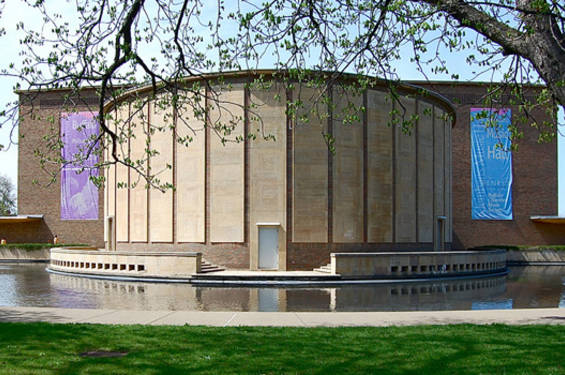This website uses cookies
This website uses cookies to enable it to function properly and to analyse how the website is used. Please click 'Close' to accept and continue using the website.



September 2009 - The Kleinhans Music Hall, Buffalo
Eliel Saarinen, by Brian Carter
Winning second prize in the prestigious international competition to design the new Tribune Tower in Chicago in 1922 was a notable achievement for the Finnish architect Eliel Saarinen. It was also to be the event that prompted the Saarinen family to move to the United States and which also subsequently brought about a series of notable yet relatively little known buildings in America that were designed by Eliel Saarinen and his son Eero.
Eliel Saarinen and his wife Loja left Finland in 1923 at a time when the economic climate there was sluggish and they were joined by Eero, at that time a boy of thirteen, and his older sister Pipsan in New York later that year. Subsequently the family moved to the mid-west where they lived in Evanston near Chicago, and when Eliel was offered a teaching appointment in Michigan the family moved to Ann Arbor in the autumn of that year.
One of Saarinen’s students was the son of George G. Booth, the publisher of the Detroit News and an enthusiastic supporter of the Arts and Crafts movement, and when he became interested in the creation of a new school, Saarinen was invited to help to design it. Cranbrook was to become a leading educational centre and a focus for arts and crafts education in the United States and not only were many of the buildings designed by Eliel Saarinen but he was subsequently appointed the Director of the Cranbrook Academy of Arts.
Eero spent his adolescent years in that design community and, after studying first in Paris and then graduating from the School of Architecture at Yale in 1934, returned to Cranbrook where he taught and worked. He collaborated with Charles Eames and together they won a series of significant competitions. In addition he worked with his father and they were to design a series of significant buildings over the next few years. The most significant of these was the Kleinhans Music Hall in Buffalo. The contract, which was signed in 1938, was also important as this was the first major commission that Saarinen received in the United States beyond Cranbrook.
Eliel and Eero developed the design for this large new public concert hall, which was named by Edward Kleinhans as a memorial to his wife and his mother. It consists of two auditoria – one to seat 3000 with a second smaller hall planned for 800.Both are shaped by the acoustic requirements of the performance spaces and connected by a generous foyer. Special furniture was designed by Charles Eames and, located on a site that is defined by Olmsted’s plan for the city, the building is mirrored in a curved reflecting pool that defines Symphony Circle.
The Kleinhans Music Hall is notable for its integration of an architectural idea and the complex technical requirements of a modern concert hall. Working with the acoustic consultant Charles C.Potwin the architects were able to create an extremely good acoustic environment and the detailing of lighting, cladding and structure are well coordinated so as to create an elegant flaring, wood paneled series of rooms linked by a sweeping open foyer.
Eliel Saarinen spoke of the shape of the violin not being “derived from a preconceived style form” and went on to suggest that “as a concert auditorium to its inmost nature is a musical instrument, its formation must derive accordingly.” Highlighted by Christ Janer as “one of the most satifying examples of Eliel Saarinen’s philosophy of design” this building is also identified as one that is “enriched by Eero’s contributions”.
Noted as “one of the outstanding examples of the art of Eliel and Eero Saarinen” the Kleinhans Music Hall in Buffalo opened in 1930. It subsequently became an exemplar for other post-World War II concert halls and perhaps most notably influenced the design of the Festival Hall in London.
Brian Carter is an architect who worked in practice with Arup in London prior to taking up an academic appointment in the USA. He was Chair of Architecture at the University of Michigan and, in 2002, was appointed Professor and Dean of the School of Architecture and Planning at the State University of New York at Buffalo. The curator of exhibitions on the work of Eero Saarinen, Albert Kahn, Peter Rice, Aires Mateus and Charles & Ray Eames he is also the author of numerous books and articles on architecture and design that have been published internationally. A contributor to several journals including Architectural Review, AD, Detail and Casabella Brian Carter is a member of the Royal Institute of British Architects and a Fellow of the Royal Society of Arts.
Look for past Buildings of the Month by entering the name of an individual building or architect or browsing the drop down list.

Become a C20 member today and help save our modern design heritage.